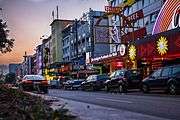Red-light district

A red-light district is a part of an urban area where a concentration of prostitution and sex-oriented businesses, such as sex shops, strip clubs, and adult theaters are found. Areas in many big cities around the world have acquired an international reputation as red-light districts.[1]
The term red-light district originates from the red lights that were used as signs of brothels.[2]
Origins of term
According to the Oxford English Dictionary, the earliest known appearance of the term "red light district" in print is in an 1894 article from the Sandusky Register, a newspaper in Sandusky, Ohio.[2] Author Paul Wellman suggests that this and other terms associated with the American Old West originated in Dodge City, Kansas, home to a well-known prostitution district during the 19th century, which included the Red Light House saloon.[3] This has not been proven, but the Dodge City use was likely responsible for the term becoming pervasive.[4] A widespread folk etymology claims that early railroad workers took red lanterns with them when they visited brothels so their crew could find them in the event of an emergency. However, folklorist Barbara Mikkelson regards this as unfounded.[5]
One of the many terms used for a red-light district in Japanese is akasen (赤線), literally meaning "red-line". (This has independent origins from the same term in English.) Japanese police drew a red line on maps to indicate the boundaries of legal red-light districts. In Japanese, the term aosen (青線), literally meaning "blue-line", also exists, indicating an illegal district.
In the United States during the 19th and early 20th centuries, the term "sporting district" became popular for legal red-light districts. Municipal governments typically defined such districts explicitly to contain and regulate prostitution.[6]
Legal issues
Some red-light districts (such as De Wallen, Netherlands, or Reeperbahn, Germany) are places which are officially designated by authorities for legal and regulated prostitution.[1] Often, these red-light districts were formed by authorities to help regulate prostitution and other related activities, such that they were confined to a single area.[7] With the confining of such industries to a single area, such districts became a destination for originally sailors, but also tourists.
Other red-light districts, such as those in Thailand, are areas which are unofficially monitored by the authorities. Some (such as those in The Hague)[8] are under video surveillance. This can help counter illegal forms of prostitution (such as child prostitution), in these areas that do allow regular prostitution to occur.
Gallery
 The Reeperbahn is a world-famous amusement mile in Hamburg, Germany
The Reeperbahn is a world-famous amusement mile in Hamburg, Germany
See also
References
- 1 2 "History of the Red light District « What you should know about Amsterdam". Whatyoushouldknowaboutamsterdam.WordPress .com. Retrieved 2012-09-01.
- 1 2 "Red light (2.)". Oxford English Dictionary. June 2010. Retrieved October 6, 2010.
- ↑ Wellman, Paul Iselin (1988). The Trampling Herd: The Story of the Cattle Range in America. University of Nebraska Press. p. 195. ISBN 0-8032-9723-8.
- ↑ Barra, Allen (2009). Inventing Wyatt Earp: His Life and Many Legends. University of Nebraska Press. ISBN 0803220588.
- ↑ Barbara Mikkelson (July 9, 2007). "Red Light District". snopes.com. Retrieved October 3, 2010.
- ↑ Woolston, Howard Brown (1921). Prostitution in the United States. New York: The Century Company. p. 105–107. ISBN 978-0-217-03857-7.
- ↑ "The Red Light District of Amsterdam". CamsterDamn. Archived from the original on 20 May 2013. Retrieved 20 February 2013.
- ↑ Camera surveillance in red-light districts in The Hague
External links
![]() Media related to Red-light districts at Wikimedia Commons
Media related to Red-light districts at Wikimedia Commons